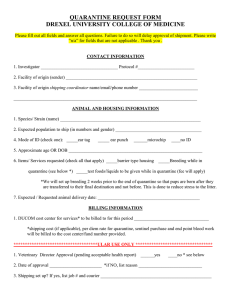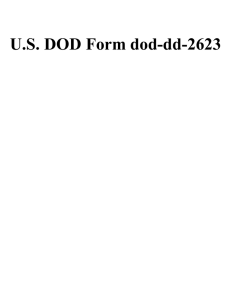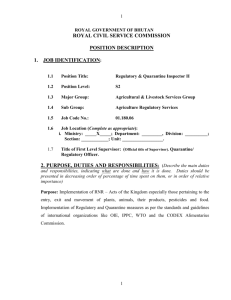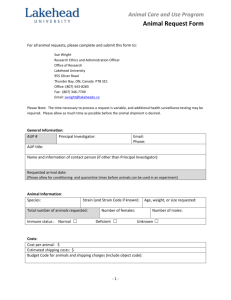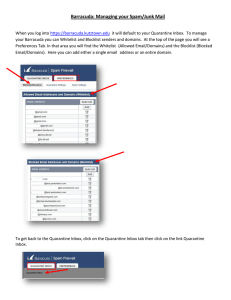U.S. DOD Form dod-secnavinst-6210-2a
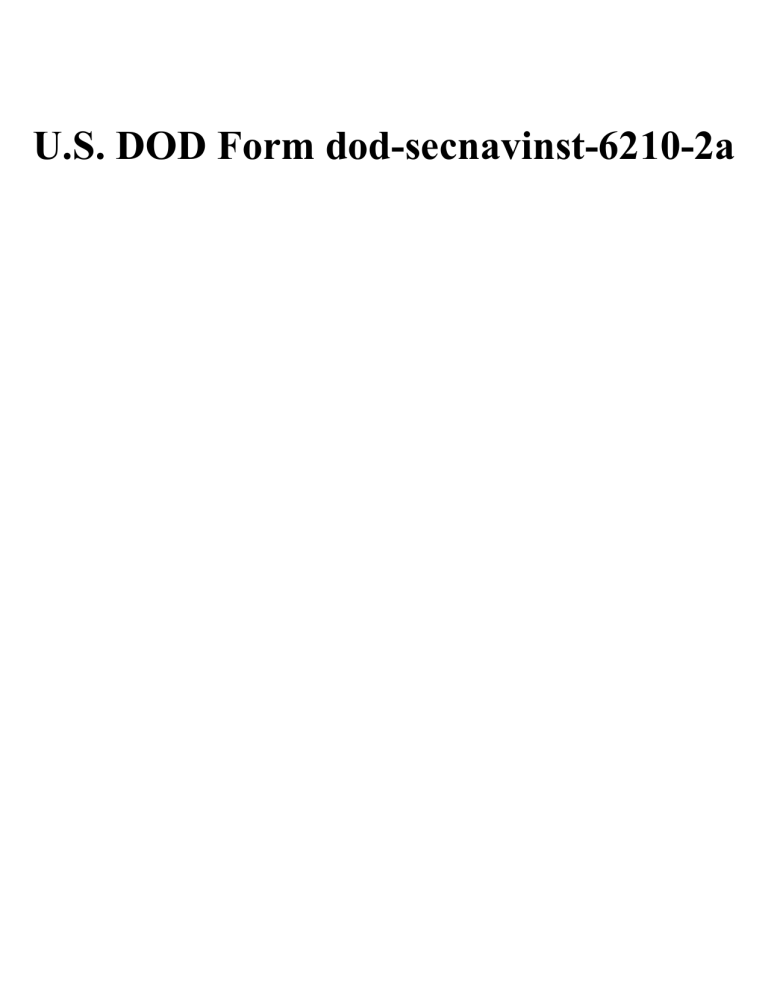
U.S. DOD Form dod-secnavinst-6210-2a
.
DEPARTMENTS OF THE
NAVY
THE ARMY, AND THE AR FORCE
Washington, DC 20350
�
6210.2A
*AR 40-12
24
January 7992
Memcal Service
QUARANTINE REGULATIONS OF THE ARMED FORCES
This directive implements current quarantine policies and procedures of the US, Public Heatth Service and the U.S. Department of Agriculture in milttary programs.
It also outlines compliance requirements with foreign quarantine regulations.
SECTION 1.
GENERAL Paragraph Page
Purpose and Scope
References
Cooperation with Other Agencies
Liaison
Quarantine Requirements
Responsibilities
SECTION Il. TRANSPORTATION:
Subsection A. PUELIC HEALTH SERVICE REQUIREMENTS-SURFACE
Predepaflure Requirements
Procedures Applicable to Arrival a! LI.S Ports
Insect and Rodent Contrcl on Ships
TRANSPORTATION
7
8
9
1
4
5
2
3
6
3
3
4
2
3
3
3
2
2
Subsection B. PUBLIC HEALTH SERVICE REQUIREMENTS-AIRCRAH
General
Quarantine ProcecJres for Alrcrafi Arriving in Foreign Countries
Quarantine Responsibilities of Aircraft Commanders
Procedures to Prevent Aircrafi Dissemmation of Disease Vectors and Pests of Medical Impofiance
Subsection C. U.S. DEPARThfE!JT
OF AGRICULTURE REQUIREME};TS
General
Command Responsibility
Procedures to Prevent Dissemination of Agricultural Pes?s
SECTION Ill. IMPORTATION OF PLANTS, PIANT PRODUCTS, SOIL PIANT p~STS, BIR~S, ANltJALS, ANlfiJAL pRODUCTS, GARSAG~, AND
INFECTIOUS AGENTS
General
Special Permits
Procedures for Using Permits
Restricted or Prohibited Irnpofiaticn
Prohibited Items
Restricted Items
10
11
12
13
14
15
16
17
18
19
20
21
22
.6
6
7
9
6
7
5
5
5
4
4
4
4
.
� These regulations supersede SECNA\’lNST 62: C).2AR 4CL12/AFR 161-I of 24 Ott 74
D579LDR55BE)4B
Inz I I Llll 11111111 –-
SECNAVI?WT
6210.2AJAR
40-12/ AFR 161-4
24
January 1992
.
SECTION IV. DOMESTIC AND TERRITORIAL FEDERAL REGULATIONS
GOVERNING MOVEMENT OF PIANT PESTS,
PUiNTS, PIANT
PRODUCTS, SOIL GARBAGE
AND OTHER HAZARDOUS
MATERIALS, AND TRANSPORTATION FACLJTIES
General
Certificates and Permits
Territorial Plant Quarantines
Domestic Plant Quarantines
SECTION V. INTERSTATE MOVEMENT OF ETIOLOGIC AGENTS
General
Etioiogic Agents
Forms
APPENDICES
A.
Armed Forces Permit Letter to Import Quarantinable Material
B.
c,
D.
Armed Forces Permit for Impofl of Quarantinable Material
Veterinay Permit to Imporl Organisms and Vectors
Importation Permit Label
Designated Ports of Ent~ for Personally-Owned Pet Birds
Paragraph
23
24
25
26
27
28
29
Page
12
12
12
12
13
13
14
A-1
A-2
B-I
c-1
D-1
15
16
17
19
21
.
Section 1.GENERAL
1. PURPOSE AND SCOPE These regulations conform to regulations of the United States Depafiments of Health and
Human Services; Agriculture, Treasury; Interior; and Commerce, The regulations are intended to prevent the introduction and dissemination, domestically or elsewhere, of diseases of humans, plants and animals, prohibited or illegally taken wildirfe, arthropod vectors, and pests of health and agricultural importance.
Introduction and dissemination may occur by movements of vessels, aircraft, or other transport of the Armed Forces arriving at or leaving Armed
Forces installations in the United States and foreign countries or ports or other facilities under the jurisdiction of the
above Federal agencies in the United States and its territories, commonwealths, and possessions.
2 REFERENCES a Required Publications
(1) DOD 5030.49-R of May ~, Customs Inspection,
Cited in par. 6.
(2) NAVFAC MO-31O,Army TM 5432, Air Force Manual 91-16, Military Entomology Operational Handbook.
Cited in par. 9.
(3) OPNAVINST 371O.2E, AFR 8-5, USAF Foreign
Clearance Guide. Cited in par. 11.
(4) AR 40-562/NAVMEDCOMINST 6230,3/AFR 161-
13/CGCOMDTINST M6230.4D, Immunization and chemoprophylaxis. Cited In par. 12.
b. Related Publications
(1) Part 71, Tfile 42, CFR, Public Health. Cited in par.
7.
(2) BUMED and NAVMEDCOM instructions in the
6250 series and NAVMED P-50104 Cited In par. 9.
(3) Section 173.387, Part 173,Tnie 49, CFR, Transportation and Section 72.3, Part 72, Tfiie 42, CFR, Public Heatth.
Cited in pa- 18.
(4) Appendix A, Part 17, Title 50, CFR, U.S. Ust of
Endangered Foreign Fish, Wildlife and Plants. Cited in par.
21e.
(5) 7 U.S.C. 150 aa et seq., Federal Plant Pest Act.
Ctted in par. 21h.
(6) 7 U.S.C. 2801 et seq., Federal Noxious Weed Act.
Cited in par. 21h.
(7) 7 CFR, Part 330, Agriculture. Cited in par. 21h.
(8) Appendix B, Part 17, Title 50, CFR, W~ldlifeand
Fisheries. Cited in par. 21k(l).
(9) 21 U.S.C. 321 et seq., Federal Food Drug and
Cosmetic Act. Cited in par. 22a.
(10) 15 U.S.C. 1261 et seq., Federal Hazardous Substances Act. Cited in par. 22a.
(11) 7 US.C. 135-135 K, Federal Insecticide, Fungicide and Rodenticide Act. Cited in par. Zb.
(12) 7 U.S.C. 1551 et seq., and CFR, Pm 201, Federal
Seed Act. Cited in par. 22c.
3. COOPERATION WITH OTHER AGENCIES. To futty comply with the quarantine regul~ions ~ the executive
(t
L
24 January 1992 SECNAVINST 621 O.WAR 40-1 2/AFR 161-4 departments referred to above, full cooperation will be given at all times to officials of these agencies. Inspectors of the
above services are authorized to board ships, aircraft, and arty other means of conveyance of the Armed Forces and to inspect pofis and other facilities. Commanders will provide full support for inspections. Cooperation will be given to foreign oft7chls following applicable host country agreements. All examinations will be subject to all restrictions necessary to preserve the securtty of classified material.
4. UAISON. Appropriate Armed Forces commanders will maintain liaison with local representatives of Plant Protection and Quarantine (PPQ) and Veterinary Services of Animal and Plant Health Inspection Sewice (APHIS), United States
Department of Agriculture (USDA); Division of Law Enforcement, Fish and Wildlife Service, United States Department of Interior; the Customs Service of the United States Treasury Department; the Public Health Service (PHS) of the
United States Department of Heatth and Human Services
(DWS); and appropriate foreign representatives, and cooperate to carry out the provisions of these regulations.
Inspectors of the above agencies will be notified by the local
Armed Forces commander in advance, so far as it may be practical, of the arrival or depaflure of any vessel, aircraft, or other conveyances of the Armed Forces under the purview of these regulations.
5. QUARANTINE REQUIREMENTS. Ships, aircraft, or other conveyances of the Armed Forces proceeding to a foreign port will meet the quarantine requirements published by proper authority for such pmt. The U.S. Government asserts the full panoply of rights of sovereign immunity with respect to U.S. warships and milita~ aircraft, USNS vessels, and afloat propositioning force ships. They will ti be subject to inspections or searches by officials for any purpose.
Commanding officers, masters, and aircraft commanders may certify compliance with quarantine regulations
and
restrictions to foreign heatth ~lciats.
If requested by host authorities, cert~cation may include a generaJdescription of measures taken by U.S. tilcials in compliance with local requirements. At the discretion of the commanding officer, master, or aircraft commander, foreign hea!th dficiak may be received on board for the purpose of recehring certification of compliance. Such @Iciais may n@ however, inspect the ship or aircraft, or act as observers while U.S. personnel conduct such inspections. Actions by foreign officials inconsistent with this guidance must be reported immediately to the chain of command and U.S. embassy.
6. RESPONSIBILITIES. The Armed Forces must compty with applicable regulations published by other Federal agencies governing the movement of diseases, pests, wildlife, and aflhropod vectors. Commanders of all echelons are responsible within their jurisdiction and wtth the advice of the appropriate technical assistant for compliance with these regulations and for the issuance and enforcement of such directives and such instructions as maybe required to meet special and unusual conditions. Commanders must also be familiar and comply with provisions of the Depadment of Defense Directive 5030.49-R, Customs inspection, and requirements of the Military Customs Inspection Pro gram. Coordination at depallment level wili be provided by the Armed Forces Pest Management Board.
Section H. TRANSPORTATION
Subsection A. PUBLIC HEALTH SERVICE RE-
QUIREMENTS - SURFACE TRANSPORTATION
7. PREDEPARTURE REQUIREMENTS a. The commanding officer of a ship will compty with sanitary measures prescribed by the heatth authorities in the port of departure to prevent the embarking of persons infected with a quarantinable disease or the introduction on board the ship of possible agents of infection or vectors of a quarantinable disease. The quarantinable diseases are cholera, plague, and yellow fever.
Note. The U.S. Public Health Service,under the authorityof an
Executive Ordersigned bythe Presidentof the UnitedStates(E.O.
12452 of December 22, 19S3) and CFRPart71 haathe authorityto detain, isolate, or placo undersurveillanceindividualsbelievedto
be infected with 4 diseasesin additionto those Iiated � bove.
The
4 diseases are: diphtheria, infectious tuberculosis, suspected smallpox, and suspectedviral hemorrhagicfevers(laaa&marburg, ebola,tong-crimean, and othersnotyet isolatedor named).
b. Those measures outlined in sections IV and V for domestic quarantines will be applied to ship Wedeptiure and arrivaJrequirements, as applicable.
8. PROCEDURES APPLICABLE TO ARRIVAL AT U.S.
PORTS a Public health quarantine procedures are required for ships which, in the last 15 days prior to arrival in the U.S. or since departure from the iast U.S. port (whichever period is shorter) have or have had any passengers or crew on board with the following conditions or illness:
(1) Has a temperature of 100° F (380 C) or greater accompanied by a rash, glandular sweliing, or jaundice, or which has persisted for more than 48 hours.
(2) Has diarrhea, defined as the occurrence In a 24 hour perbd of three or more Ioosa stools or of a greater than normal (for the person) amount of loose stool.
(3) Death due to illness other than battle casualties or physical injuries.
b. When one or more of the above conditions exist, the commanding officer of a ship, or senior tilcer of a group of ships will, between 12 and 72 a radio report or message of condklons to the senior naval officer In command at the poII of =rNal. For ships of the other Armed Forces, the report wiil be sent to such author”~ as appropriate and to the local port authority. Send informs-
SECNAVINST 621 0.2A/AR 40-12/ AFR 161-4 24 January 1992 tion copies to the militaty quarantine inspector and to the responsible local preventive medicine service in the port
area A reply confirming receipt of the radb message or report will be made If circumstances indicate and will contain applicable quarantine instructions, Unless otherwii hdi cated in the repty, a ship may proceed directly to berth and begin normal business acthrity, This quarantine procedure does ti exempt a ship from control measures or public health inspection subsequently deemed neceawy, or from the requirements d other Government agencies. When {11 ness is repOf’t@ or if the ship has been in a plague-infected country, appropriate inspections may be required. tional protective measure against rodent entry, dependent upon locai conditions. d. Oerafting and Demfting Grempfion Certlflcates. By international convention, a Deratting and Deratting Exemp tion Certificate Is required of ships entering most foreign ports, H detention is to be avoided. A certtfiie must be issued by a USPHS ofker or a Public Heatth Service des ignated mllitafy quarantine representative, The certificates are valid for 6 months. Procedures for procurement and issue of certificates are contained in BUMED and
NAVMEDCOM instructions d the 6250 series.
9. INSECT AND RODENT CONTROL ON SHIPS a. General Insect Control. Ship disinfection by approved methods wili be accomplished as required for protecting the personnel aboard from arthropod-borne diseases and for preventing the dissemination of insect pests and disease vectors. Dissection wiii ahvays be accomplished during vistts to and upon leaving ports where yellw fever, maiark+ or other arthropod-borne diseases are known to exist. Sim ilarly, special attention wili be directed mo dislnsection of ships proceeding from areas where yellow fever or malaria mosquitoes exist to areas where these insects do not exist.
Information on materials and methods may be found In the
Military Entomology Operational Handbook (NAVFAC MO
310, Army TM 5-632, Air Force AFM 91=16), Bureau of
Medicine and Surgery and Naval Medical Command in structions of the 6250 series, and NAVMED P-50104, or may be obtained from the military or public heatth quarantine inspector in port. b. Preventing RatandFlea Infestations. Appropriate mea sures will be taken in piague-endemic areas to avoid rat and flea infestations. Such measures include the following:
(1) Immediately upon berthing at a pier and during the entire time a ship iies alongside a pier, it shouid be fended off al least 6 feet; gangways and other means of access to the ship wiil be guarded and weli-lighted or separated from the shore; cargo nets and similar devices extending be tween the ship and shore wili be raised or removed unless in actual use, and all connecting iines will be property f~ed with rat guards.
(2) The ship wiil load only cargo that has been found free from or has been treated to destroy rats and fleas.
(3) Prior to departure, the ship wili be inspected for rats
and fleas,
and measures will be taken to ensure destruc tion of any that are present. These same measures maybe used as protection against rat infestation in other ports, but use of ratguards is no longer mandatory at ports where no plague is reported. c. Rafguarcfs. International heatth regulations no longer require the use of ratguards by ships except when the ship is berthed in a pott where piague is endemic. However, continuing efforts to prevent entry of rodents onto the ship and sanitary measures to eiiminate food and harborage sources aboard the ship are stiil necessary, particularity in areas where large populations of rodents are known to be present. Accordin$iy, there may be instances when com manding officers or Medical Department representatives determine the use of ratguards to be advkable as an addi
Subsection B. PUBUC HEALTH SERVICE RE-
QUIREMENTS - AIRCRAFT
10. GENERAL To minimize the
hazard of
introducing or disseminating human diseases and arthropod vectors of medical importance by Armed Forces aircraft, preventive measures wili be emphasized at the aeriai port of embarka tion. Commanding officers at all echelons must be cogni zant of and must compty with ail applicable domestic and foreign quarantine regulations.
11. QUARANTINE PROCEDURES FOR AIRCRA~ AR-
RIVING IN FOREIGN COUNTRIES a When flights are contemplated to foreign countries or ianding is to be made at any airpofl not under Armed Forces jurisdiction, the aircraft commander will abide by the medlcai and agricutturai quarantine regulations published for landing at the airport concerned. (See USAF Foreign Clearance
Guide, AFR 8-5, and OPNAViNST ‘371O.2E for individual country requirements.) b. Commanders of Armed Forces installations located in foreign countries will publish local directives to assure that agricultural and public health quarantine requirements and procedures of the host country are obsewed by arriving aircraft. Overseas commanders will recommend changesto
AFR 8-5 If indicated. Suggested changes to AFR 8-5 must be sent to HQUSAF/XOXXG, Washington, DC 20330.
12. QUARANTINE RESPONSIBILITIES OF AIRCRA~
COMMANDERS a. AR 40-562/NAVMEDCOM lNST 6230.3/AFR 161-
13/CGCOMDTINST M6230.4D, paragraph 2, task port com manders with the responsibility for ensuring that travelers meet the immunization requirements for the areas to which they are traveling. b, On each fright to the United States, Its territories, commonwealths, or possessions, when illness has oc curred characterized by the signs and symptoms in para graph 8a(1) and (2), the aircraft commatierwiil send a radio message requesting an Inspection by the military w public health quarantine inspectors. The request should be made at the earliest feasible time at which cream can be made with the airport of arrival.Upon landing, ali persons must be piaced in a sdtabie isolation area by the aircraft commander until released by designated Armed Forces quarantine pe~ sonnel.
“
4
